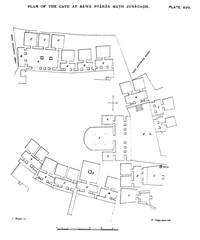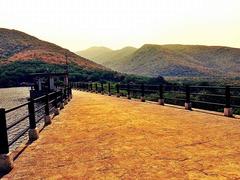
Visiting Khapara Kodiya Caves: Hours, Tickets, and Historical Insights
Date: 31/07/2024
Introduction
Discover the Khapara Kodiya Caves, one of Gujarat’s hidden gems dating back to the 3rd-4th century BCE. These ancient rock-cut caves, located within the Uparkot Fort complex in Junagadh, are a testament to the spread of Buddhism during the reign of Emperor Ashoka. The caves offer a fascinating glimpse into the early monastic life of Buddhist monks and showcase the advanced engineering skills of the period. While they may lack the elaborate decorative elements seen in other Buddhist cave complexes, their unique architectural features, including a sophisticated water management system, make them a significant site for historical and cultural exploration. This comprehensive guide will provide you with all the essential information you need to plan your visit, including the historical background, visiting hours, ticket prices, travel tips, and nearby attractions (eindiatourism, myholidayhappiness, imvoyager).
Table of Contents
- Introduction
- Historical Background
- Visitor Information
- Preservation and Modern-Day Significance
- Conclusion
- FAQ
Historical Background
Origins and Construction
The Khapara Kodiya Caves, also known as Khangar Mahal, are the oldest among the Junagadh Buddhist Cave Group, dating back to the 3rd-4th century BCE during the reign of Emperor Ashoka. These caves are a testament to the early spread of Buddhism in the region of Gujarat. The caves were carved into living rock, a technique that showcases the advanced engineering skills of the period. The primary purpose of these caves was to serve as monastic quarters for Buddhist monks, making them one of the earliest monastic settlements in the area (eindiatourism).
Architectural Features
The Khapara Kodiya Caves are relatively plain compared to other Buddhist cave complexes in India. They lack elaborate decorative elements but are significant for their unique architectural features. The caves are carved into an east-west longitudinal ridge and include a series of chambers and water tanks. The western wing of the caves is rectangular and features a grid-like pattern of water tanks, which likely served as the site’s water supply (myholidayhappiness).
One of the most intriguing aspects of the Khapara Kodiya Caves is their water management system. The caves include a series of interconnected water tanks designed to collect and store rainwater, ensuring a reliable water supply for the monks. This system reflects the advanced understanding of hydraulics and water conservation techniques during that period (imvoyager).
Historical Significance
The Khapara Kodiya Caves hold immense historical significance as they provide insights into the early spread of Buddhism in Gujarat. Emperor Ashoka, who ruled from 268 to 232 BCE, was a pivotal figure in the propagation of Buddhism across India. His reign saw the construction of numerous Buddhist monuments, including the Khapara Kodiya Caves. These caves serve as a physical manifestation of Ashoka’s efforts to promote Buddhism and provide a glimpse into the monastic life of Buddhist monks during that era (wikipedia).
Decline and Abandonment
Despite their initial significance, the Khapara Kodiya Caves were eventually abandoned. Over time, cracks developed within the caves, allowing water to seep into the living quarters and rendering them uninhabitable. This led to the monks relocating to other regions, including Maharashtra, where they continued to carve more elaborate cave complexes. The abandonment of the Khapara Kodiya Caves marks a significant transition in the history of Buddhist monastic settlements in India (eindiatourism).
Connection to Uparkot Fort
The Khapara Kodiya Caves are located within the Uparkot Fort, a historical fort built by Chandragupta Maurya in 319 BCE. The fort itself is a significant historical site, covering an area of about 70 acres and featuring a moat and high walls. The fort’s strategic location on a plateau in the eastern part of Junagadh city, at the foot of the Girnar hills, made it an ideal site for both military and monastic purposes. The proximity of the caves to the fort underscores the interconnectedness of military and religious activities during that period (eindiatourism).
Influence on Later Buddhist Architecture
The architectural style and techniques used in the Khapara Kodiya Caves influenced later Buddhist cave complexes in India. The monks who abandoned these caves due to water seepage issues went on to carve more elaborate structures in Maharashtra, such as the Ajanta and Ellora caves. These later caves incorporated more sophisticated designs and decorative elements, reflecting the evolution of Buddhist cave architecture over time (imvoyager).
Visitor Information
- Visiting Hours: The caves are open to the public from 9:00 AM to 5:00 PM daily.
- Tickets: Entry tickets are priced at INR 50 for Indian nationals and INR 200 for foreign tourists.
- How to Get There: The caves are located within the Uparkot Fort in Junagadh. Visitors can reach Junagadh by train or bus from major cities in Gujarat.
- Nearby Attractions: While visiting the Khapara Kodiya Caves, explore other nearby attractions such as the Uparkot Fort, Girnar Hills, and the Mahabat Maqbara.
Preservation and Modern-Day Significance
Today, the Khapara Kodiya Caves are preserved as a significant historical and cultural site. They offer valuable insights into the early spread of Buddhism in Gujarat and the architectural and engineering skills of the period. The caves are a popular tourist attraction, drawing history enthusiasts and scholars alike. Visitors can explore the simple yet intriguing architecture of the caves and learn about the monastic life of Buddhist monks during the reign of Emperor Ashoka (myholidayhappiness).
Conclusion
The Khapara Kodiya Caves offer a unique glimpse into the early spread of Buddhism in Gujarat. Their architectural ingenuity and historical significance make them a must-visit for history enthusiasts. Plan your visit today to explore this ancient marvel and its surrounding attractions.
Call to Action
Don’t miss out on exploring more historical sites like the Khapara Kodiya Caves. Download our mobile app Audiala for more travel tips and follow us on social media for the latest updates.
FAQ
- What are the visiting hours for Khapara Kodiya Caves? The caves are open to the public from 9:00 AM to 5:00 PM daily.
- How much are the tickets for Khapara Kodiya Caves? Entry tickets are priced at INR 50 for Indian nationals and INR 200 for foreign tourists.
- How to get to Khapara Kodiya Caves? The caves are located within the Uparkot Fort in Junagadh. Visitors can reach Junagadh by train or bus from major cities in Gujarat.


